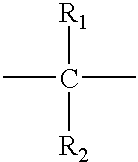Liquid crystal composition, liquid crystal device, driving method thereof and liquid crystal apparatus
- Summary
- Abstract
- Description
- Claims
- Application Information
AI Technical Summary
Benefits of technology
Problems solved by technology
Method used
Image
Examples
example 2
The active matrix-type liquid crystal device prepared in Example 1 was continuously supplied with a pulse waveform for displaying the white (display) state for 100 hours. Thereafter, when the liquid crystal device was subjected to measurement of transmittances in the respective display states (W1 to B4) in the same manner as in Example 1 by using the pulse signal waveform shown in FIG. 5, the liquid crystal device showed transmittances substantially identical to those of the liquid crystal device used in Example 1. Accordingly, the active matrix-type liquid crystal device of the present invention was found to be effective in suppressing an occurrence of burning (sticking) of the liquid crystal material used.
example 3
An active matrix-type liquid crystal device was prepared and evaluated in the same manner as in Example 1 except that the liquid crystal composition LCC-1 was changed to a liquid crystal composition LCC-2 prepared by using three fluorine-containing compounds A, B and D in a mixing ratio of A / B / D=37 / 55 / 8 (wt. %). The liquid crystal composition LCC-2 showed a spontaneous polarization (Ps) of 9.6 nC / cm.sup.2 at 30.degree. C.
As a result of the transmittance measurement, the active matrix-type liquid crystal device showed the following transmittances.
The active matrix-type liquid crystal device could effect an optical modulation with a good reproducibility without substantially causing hysteresis phenomenon.
Further, when the active matrix-type liquid crystal device was evaluated in the same manner as in Example 2, the liquid crystal device showed the same transmittances as those measured above, thus providing a good burning-prevention performance.
example 4
The active matrix-type liquid crystal device prepared in Example 1 was partially supplied with a pulse signal as shown in FIG. 5 so that the pulse signal application was effected until a time immediately before the start of application of the reset pulse in a frame period for G3 (i.e., until half of the frame period of G3) and after 1 sec., the gate was opened thereby to place the liquid crystal molecules in a state of no electric field application. In this state, the liquid crystal device provided the intermediate (gray) display state based on a co-presence of two domains (domain gradation memory state).
When the active matrix-type liquid crystal device prepared in Example 3 was similarly evaluated, the liquid crystal device was found to maintain a domain gradation memory state (G3 display level) similar to that observed above.
Accordingly, the active matrix-type liquid crystal device of the present invention was found to be applicable to a partial motion picture display mode, a part...
PUM
 Login to View More
Login to View More Abstract
Description
Claims
Application Information
 Login to View More
Login to View More - R&D
- Intellectual Property
- Life Sciences
- Materials
- Tech Scout
- Unparalleled Data Quality
- Higher Quality Content
- 60% Fewer Hallucinations
Browse by: Latest US Patents, China's latest patents, Technical Efficacy Thesaurus, Application Domain, Technology Topic, Popular Technical Reports.
© 2025 PatSnap. All rights reserved.Legal|Privacy policy|Modern Slavery Act Transparency Statement|Sitemap|About US| Contact US: help@patsnap.com



